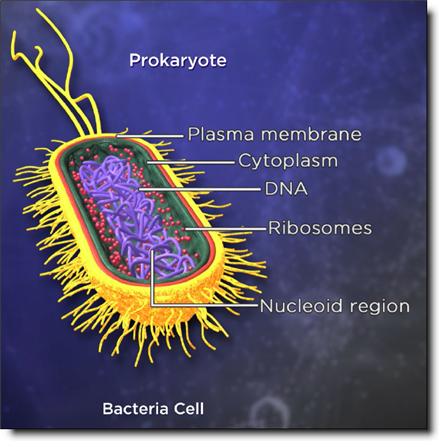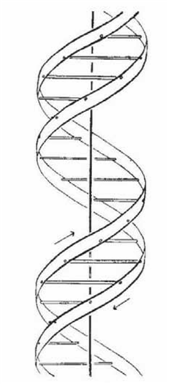RWS-00 Introduction to DNA
 Some parts of this site are currently incomplete & will be updated asap
Some parts of this site are currently incomplete & will be updated asap
Other parts will change continually so use “Refresh” in your browser !!
There is extensive use of “Tooltips” text to support learning which do not seem to render on a Smartphone, so this site is best viewed via a computer’s HD monitor
Learning -> Resources Available, All Work is Subject to DHRF's "GD"
DNA - What is it?
DNA is Deoxyribose Nucleic acid
“Deoxyribonucleic acid - DNA - is a molecule composed of two polynucleotide chains that coil around each other to form a double helix carrying genetic instructions for the development, functioning, growth and reproduction of all known organisms and many viruses”
The “two polynucleotide chains” or in other words “the two DNA strands” are “antiparallel”
More on DNA as a Data Structure
This is the original DNA Double-Helix paper by (Watson and Crick 1953)
The Genome
DNA makes up an organism’s Genome
“… a genome is all the genetic information of an organism. It consists of nucleotide sequences of DNA (or RNA in RNA viruses). The genome includes both the genes (the coding regions) and the noncoding DNA, as well as mitochondrial DNA and chloroplast DNA. The study of the genome is called genomics”
Source: Wikipedia (DHRF Emphasis)
The Importance of Odile Crick’s Double Helix Diagram 2
“Odile Crick (11 August 1920 – 5 July 2007) was a British artist best known for her drawing of the double helix structure of DNA discovered by her husband Francis Crick and his partner James D. Watson”
“Francis Crick and James Watson asked her to draw an illustration of the double helix for their paper on DNA for Nature in 1953. The sketch was reproduced widely in textbooks and scientific articles and has become the symbol for molecular biology. Terrence J. Sejnowski of the Salk Institute for Biological Studies said, ‘It may be the most famous [scientific] drawing of the 20th century, in that it defines modern biology’“
“However, she was not aware at first of the importance of the discovery. In his memoir What Mad Pursuit, Crick said that she had told him later ‘You were always coming home and saying things like that, so naturally I thought nothing of it’“
“Several exhibitions have been held of Crick’s paintings of curvaceous nudes. Her models included their au pairs for the children and her husband’s secretaries”
“The Cricks became famous for their parties in the 1960s either in Cambridge or at a cottage near Haverhill. At one party, a nude model posed on a couch to encourage their guests to become amateur painters” 3
Learning Resources: An Introduction to DNA
DNA’s History 4
- 1869 - DNA was first isolated by the Swiss physician Friedrich Miescher who discovered a microscopic substance in the pus of discarded surgical bandages
- 1878 - Albrecht Kossel isolated the non-protein component of “nuclein”, nucleic acid, and later isolated its five primary nucleobases
- 1909 - Phoebus Levene identified the base, sugar, and phosphate nucleotide unit of the RNA
- 1927 - Nikolai Koltsov proposed that inherited traits would be inherited via a “giant hereditary molecule” made up of “two mirror strands that would replicate in a semi-conservative fashion using each strand as a template”
- 1928 - Frederick Griffith in his experiment discovered that traits of the “smooth” form of Pneumococcus could be transferred to the “rough” form of the same bacteria by mixing killed “smooth” bacteria with the live “rough” form
- 1929 - Phoebus Levene identified deoxyribose sugar in “thymus nucleic acid” (DNA)
- 1933 - While studying virgin sea urchin eggs, Jean Brachet suggested that DNA is found in the cell nucleus and that RNA is present exclusively in the cytoplasm
- 1937 - William Astbury produced the first X-ray diffraction patterns that showed that DNA had a regular structure
- 1943 - Oswald Avery, along with co-workers Colin MacLeod and Maclyn McCarty, identified DNA as the transforming principle, supporting Griffith’s suggestion (Avery–MacLeod–McCarty experiment)
- 1951 - Francis Crick started working with James Watson at the Cavendish Laboratory within the University of Cambridge
- 1952 - DNA’s role in heredity was confirmed Alfred Hershey and Martha Chase in the Hershey–Chase experiment showed that DNA is the genetic material of the enterobacteria phage T2
- 1952 - Raymond Gosling, a graduate student working under the supervision of Rosalind Franklin, took an X-ray diffraction image, labeled as “Photo 51”, at high hydration levels of DNA
- 1953 - February: Linus Pauling and Robert Corey proposed a model for nucleic acids containing three intertwined chains, with the phosphates near the axis, and the bases on the outside
- 1953 - February: Watson and Crick completed their model, which is now accepted as the first correct model of the double-helix of DNA
- 1953 - 28th February: Crick interrupted patrons’ lunchtime at The Eagle pub in Cambridge to announce that he and Watson had “discovered the secret of life”
- 1953 - April 25: Watson & Crick’s seminal paper is published in the Nature scientific journal (Watson and Crick 1953)
- 1957 - Crick laid out the central dogma of molecular biology, which foretold the relationship between DNA, RNA, and proteins, and articulated the “adaptor hypothesis”
- 1962 - Watson, Crick, and Wilkins jointly received the Nobel Prize in Physiology or Medicine
So it can be seen that there is a long history of a work being done on DNA before Watson & Crick’s paper in 1953 and this is in the classic tradition of the scientific method where knowledge is shared by researchers
What is DNA’s Role ?
“DNA is important because it serves as a reliable way of storing information” (Enger et al. 2012, p. 155)
“DNA is a single molecule that has all of the information for making all of the proteins in each of the body’s trillions of cells” 5 (Ahern 2019, p. 255)
“Deoxyribonucleic acid (DNA) is an informational molecule that contains in the sequence of its nucleotides the information required to build all the proteins and RNAs of an organism, and hence the cells and tissues of that organism” 5 (Lodish et al. 2016, p. 167)
“The main role of DNA is information storage. In all living cells, from unicellular bacteria to multicellular plants and animals, DNA is the material in which genetic instructions are stored and is the chemical structure in which these instructions are transmitted from generation to generation; all the information required to make and maintain a new organism is stored in its DNA. Incredibly, the information required to reproduce even very complex organisms is stored on a relatively small number of DNA molecules. This set of molecules is called the organism’s genome” 5
(Karp 2013, p. 4)
“Genetic information: Biological information is carried by the nucleic acid molecules, deoxyribonucleic acid (DNA) and ribonucleic acid (RNA). The units of genetic information are known as genes, and each consists physically of a segment of a nucleic acid molecule. DNA is used for long-term storage of large amounts of genetic information. Whenever genetic information is actually used, working copies of the genes are carried on RNA. The total genetic information possessed by an organism is known as its genome. DNA genomes are maintained by replication, a process where a copy of the DNA is produced by enzymes and then passed on to the daughter cells” 5
(Clark and Pazdernik 2013, p. 3)
![]()
Scientific Method Stage 1 - Make Descriptive Observations:
RWS00/DO-0001 DNA (‘the Genome’) is functionally equivalent to ‘Read-only-Memory’ (‘ROM’) Discussion
![]()
“The two types of nucleic acids, deoxyribonucleic acid (DNA) and ribonucleic acid (RNA), enable living organisms to reproduce their complex components from one generation to the next. Unique among molecules, DNA provides directions for its own replication. DNA also directs RNA synthesis and, through RNA, controls protein synthesis” 5
(Reece et al. 2014, p. 84)
All the above descriptions of DNA’s role are rather incomplete, and in some cases quite vague. This is very unsatisfactory as a lack of explicitness is ultimately an impediment to research and understanding
Out of all the biology textbooks DHRF looks at, (Hoefnagels 2018) seems to be the ONLY TEXTBOOK that is explicit on this particular topic, starting by saying “DNA is an information storage molecule; its main function is to carry the “recipes” for the proteins that do the cell’s work” and then presenting two very explicit and insightful diagrams, shown below

Above: based upon a diagram from (Hoefnagels 2018, p. 112) Verification (in new page)

Based upon Fig 7.28 from (Hoefnagels 2018, p. 137) Verification (in new page)
When (Hoefnagels 2018) says: “DNA is an information storage molecule; its main function is to carry the “recipes” for the proteins that do the cell’s work”, the process being referred to is the DNA Central Dogma
This is discussed in detail in Research Work Stream 3 where an astonishing functional equivalence is described between the DNA Central Dogma and the fig-Forth Colon Compiler (in the Computer Science Knowledge Domain)
Scale & level of present observations:

Based on (Raven et al. 2019, p. 2) Figure 1.1 Mark-up in RED by David Husband
Verification (in new page)
We are looking at the Cellular Level and at the DNA Macromolecule
“At the cellular level (figure 1.1), atoms, the fundamental elements of matter, are joined together into clusters called molecules. Complex biological molecules are assembled into tiny structures called organelles within membrane-bounded units we call cells. The cell is the basic unit of life. Many independent organisms are composed only of single cells” (Raven et al. 2019, p. 25)
“Macromolecules ( macro = large) are very large organic molecules” (Enger et al. 2012, p. 49)
What is a cell?
“Cells are the fundamental unit of life. Overall, you could think of cells as houses for molecular reactions. Like houses, cells have surrounding walls in the form of a membrane. Some cellular houses are more like tents, with a simple design, small size, and only a single room for the reactions to live in. Bacteria cells have single rooms. They are also called prokaryotes. With no internal walls, bacterial houses keep all their possessions in the same room”
(Ahern 2019, p. 13)

Based on (Ahern 2019, p. 13) Verification (in new page)
Learning Resources: An Introduction to the Cell - Bacteria
This Research Work Stream continues in the next Research Work Stream
References:
Watson, J. D. and Crick, F. H. C., 1953. Molecular structure of nucleic acids. Nature, 9 (4356), 96–98.
Ahern, K., 2019. Biochemistry and Molecular Biology. The Great Courses.
Lodish, H., Berk, A., Zipursky, S. A., Matsudaira, P., Baltimore, D. and Darnell, J. E., 2016. Molecular cell biology. 8th ed. New York: W.H. Freeman.
Karp, G., 2013. Cell and Molecular Biology: Concepts and Experiments. 7th ed. Wiley.
Clark, D. and Pazdernik, N. J., 2013. Molecular Biology. Waltham, MA: Academic Press.
Reece, J. B., Wasserman, S. J., Urry, L. A., Minorsky, P. V., Cain, M. L. and Jackson, R. B., 2014. Campbell Biology. Boston: Pearson.
Hoefnagels, M., 2018. Biology : The essentials. New York, NY: McGraw-Hill Education.
Raven, P. H., Johnson, G. B., Mason, K. A., Losos, J. B. and Singer, S. R., 2019. Biology. 12th ed. New York: McGraw-Hill Education.
Enger, E. D., Ross, F. C. and Bailey, D. B., 2012. Concepts in Biology. 14th ed. New York: McGraw-Hill.
In view of DHRF’s commitment to support learning, there is a much higher “learning content” in the Research Work Streams than would otherwise be the case… Please be aware of that ↩
All the text quoted in this section has been adapted by DH, based upon Wikipedia: DNA History ↩
Sounds very much like “good, clean fun”… ↩
All the text with dates quoted in this section has been adapted by DH, based upon Wikipedia: DNA History ↩
